The 10 Common Types of Water Filtration System at Home
There are many types of home water purification system (or water filter) available in the market, and each of them utilizes different water purification technologies to produce cleaner, safer and better water for you and your family.
But, do you know which one is the best type of water filtration system at home?
You’ll know right after this guide.
With more and more of contaminants found in our water due to industrial and environmental factors, it’s crucial for us to understand more about different water purification technologies and protect ourselves with water filters.
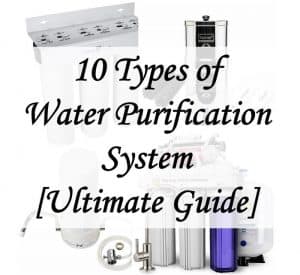
Why You Should Use Water Filtration System at Home over Bottled Water
First, the operating cost of a home water purification system is much lower compared to bottled drinking water.
Yes, you will need to come out more money at the beginning to purchase the water filter, but you will definitely see the significant saving a few months down the road.
Next, the issue with bottled water is not really just about the cost, but their plastic bottles that are hard to recycle, which are causing serious pollution to our lovely earth!
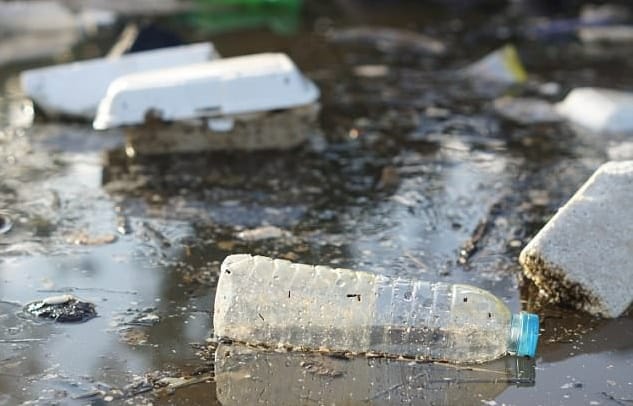
If you want to contribute your little part to our environment, get a water filtration system at home and get away from bottled water as soon as possible. I’d left since many years ago and never looked back (I’m glad I did, you can too if haven’t yet).
Last, get a water filter for your convenience, especially if you have a large family.
Why waste your petrol and time to shop at the grocery store for bottled water while you can have a clean and safe drinking water right from your water tap or private well?
Understanding Your Water Sources (Quick)
There are two common sources of water for the household:
- Municipally Treated Water
- Private Well Water
Municipally Treated Water
For most developed cities, the residents are able to get municipally treated water (or called city water) at a cost.
These water are safe to use because they were undergoing a series of treatment processes before reaching your house tap.
The water collected from the river, reservoir, and the lake will go through treatment processes like:
1. Screening – To strain out the large particles from collected water.
2. Coagulation and Flocculation – Chemicals with positive charges like aluminum sulfate and ferric chloride are added into the water to combined residual particles into larger particles (or called floc).
3. Sediment filtration – To further filter out the remaining particles.
4. Contaminants filtration – This process use mix media filters like sand, gravel, and granular activated carbon (GAC) to get rid of contaminants, bad taste, and odor.
5. Disinfection process – The popular methods are Chlorination and Chloramination, which add Chlorine or Chloramines into the water to kill microorganisms like bacteria and viruses.
6. Storage & Distribution – Lastly, the clean treated water will be store in multiples large water storage tank and distribute to all the houses, shop lots, industries, and more places through a well-designed pipeline system.
That’s how you get your clean water right from the tap.
But, the water will still get contaminated along with the pipeline system before reaching your house, so you are still required to install a water filtration system to get better quality water for your showering, kitchen use, washing machine, and drinking.
Private Well Water
For households with private wells and rural houses that unable to get municipally treated water, the well’s water becomes their primary source of water.
These wells water are from the ground, and are more polluted and may cause illness. It’s necessary to test the water quality of your private well in the lab at least once a year for safety wise.
Some potential contaminants in well water are microorganisms, nitrate, heavy metals like arsenic, organic chemicals like pesticides, fluoride, and more.
If you are using well water, it’s highly recommended to get a strong water filtration system like Reverse Osmosis (RO) system to remove all the common contaminants and purify the water prior to use for bathing, cooking, and drinking.
Most of the time, you may also need a water softener before the main water filtration system since the well water is usually hard due to minerals from rocks and soil.
Another issue with well water is the possibly high iron content which causes stains and may damage your electrical appliances. So your water softener or water filter needs to have the ability to deal with iron.
Also, make sure your water filtration system can get rid of sulfur taste and odor that often found in well water, which smells like a rotten egg.
Harmful Contaminants In Water

Contaminants can refer to any other substances other than water molecules in water like chemical (eg: pesticides, toxins), physical (eg: sediment, particles), biological (eg: bacteria, parasites, viruses), and radiological (eg: uranium, plutonium) substances including all the beneficial minerals like calcium and potassium.
The contaminants in water can either exist naturally or human-made.
For instance, the river water near the jungle may contain naturally-exist microorganisms and sediments from the soil. While the lake water near a vegetable farm may contain human-made chemicals like pesticides and herbicides.
There’s always some contaminants in our drinking water, some of them are harmless to our body (if not beneficial), but some are harmful when consumed at certain amounts.
So let’s study some common contaminants found in our water and their harmfulness.
Those harmful contaminants are the ones that you need to remove from your water by using a water filter.
2 Types of Harmful Effect from Contaminants
We knew that some of the contaminants in water are harmful to our body health, and the harmful effects can be group into 2 types:
- Acute – Harmful effects that occur with short term exposure (within hours or days)
- Chronic – Harmful effects that occur with long term exposure (after years)
For instance, some contaminants are not harmful when ingesting in low doses, but they can cause a serious impact on your health after ingested for a long period of time.
The Chronic effects can cause severe problems to your health, such as liver and kidney problems, cancers, reproductive problems, and neurological deficits.
While for some contaminants (like bacteria and viruses), they will cause harmful effect to your body shortly after you ingested certain levels.
The acute effects usually do not have permanent effects on human health, but too much ingestion may cause serious illness or death.
Harmful Contaminants Effects on Health

Most of the harmful contaminants listed below require a certain level to be harmful to the human body, some need a significant amount while some need only a small amount.
Microorganisms:
- Bacteria (eg: Fecal Coliform and Escherichia Coli) – Can cause gastrointestinal illness like vomiting, diarrhea, and cramps. (Must be treated before consumption)
- Viruses – Can cause gastrointestinal illness like vomiting, diarrhea, and cramps. (Must be treated before consumption)
- Cysts (eg: Cryptosporidium and Giardia) – Can cause gastrointestinal illness like vomiting, diarrhea, and cramps.
Note: These microorganisms may pose a health risk and cause fatal damage to people with a poor immune system.
Organic Contaminants:
- Organic Chemicals (eg: Benzene) – May cause liver, kidney, stomach, intestinal, thymus gland, thyroid, spleen, skin, eye, blood, cardiovascular system, and nervous system problems. Also can cause anemia, immune deficiencies, reproductive difficulties, and increased risk of cancer.
- Volatile Organic Compounds (VOCs) – May cause damage to the liver, kidney, and central nervous system. Exposure to VOCs may also cause headaches, dizziness, nausea, and irritation of eye, nose, and throat. Some organics can even cause cancer in the human body.
Inorganic Chemicals:
- Arsenic – May damage skin and circulatory system. Also known as a human carcinogen that long-term exposure may lead to chronic arsenic poisoning which causes skin cancer and skin lesions. (Max 0.010 mg/L)
- Chlorine – May cause eye and nose irritation, stomach discomfort, serious dry skin and hair, and may form disinfectant byproducts that cause cancer. Also, produce Chlorine taste and odor which is not preferred by consumers.
- Chloramines – May cause eye and nose irritation, anemia, stomach discomfort, and may form disinfectant byproducts that cause cancer.
- Copper – May cause gastrointestinal problems like vomiting and stomach irritation, and cause stains to hair, fabrics, and appliances. Long term exposure to Copper may lead to liver and kidney damage, and also Wilson’s disease if too much. (Max 1.0 mg/L)
- Cadmium – May lead to poisoning which causes gastrointestinal illness like diarrhea, nausea, vomiting, and cramps. Long term exposure may cause kidney damage, lung damage, and fragile bone. (Max 0.005mg/L)
- Chromium – Excess Chromium may cause allergic dermatitis, ulceration and skin irritation. Long term exposure may cause liver, kidney, circulatory, and nerve tissues damage. (Max 0.1 mg/L)
- Lead – May cause lead poisoning that causes kidney problem, high blood pressure, tiredness, and aching bones. Lead exposure to kids may delay their physical and mental development, and affect their learning abilities. (Max 0.015 mg/L)
- Mercury – Long -term exposure may cause kidney damage. (Max 0.002 mg/L)
- Fluoride – Excess fluoride can lead to bone disease like skeletal fluorosis which cause serious damage to bones and joints. Long term exposure to fluoride may cause permanent brown stains on teeth and damage to tooth enamel and parathyroid gland. For kids, too much fluoride may affect child development and cause mottled teeth. (Max 4.0 mg/L)
- Selenium – Too much Selenium may cause hair loss, fingernail loss, numbness in fingers or toes, fatigue, and irritability. Long term exposure can cause kidney, liver, peripheral nervous system, and circulatory damage. (Max 0.05 mg/L)
- Thallium – Excess Thallium may cause gastrointestinal irritation, nerve damage, and changes in blood chemistry. Long term exposure can cause kidney, liver, testicular tissues, intestinal, and hair loss problems. (Max 0.002 mg/L)
- Nitrate/Nitrite – Excess nitrate can lead to serious brain damage or death for infants with age below 6 months. (Max 10 mg/L for Nitrate; Max 1 mg/L for Nitrite)
- Pesticides – Acute toxicity of some pesticides may cause gastrointestinal illness (nausea, vomiting, and diarrhea), respiratory tract, eye, and skin irritation, sore throat, cough, headache, allergic, loss of consciousness, seizures, and death. Chronic toxicity may lead to the development of Parkinson’s disease, depression and anxiety, attention deficit and hyperactivity disorder (ADHD), asthma, cancers like non-Hodgkin lymphoma and leukemia, birth defects, and neurodevelopmental disorders.
- Herbicides – Some herbicides may cause skin rashes, increase in cancer risk, reproductive organs and body hormonal problems, and death.
- Sulfate – Excess amount may cause diarrhea, and smell like a rotten egg. (Max 250 mg/L)
- Zinc – Excess amount of zinc can cause gastrointestinal illness like nausea, vomiting, and cramps. Long term exposure may cause anemia and pancreas damage. (Max 5.0 mg/L)
- Silver – May causes discoloration to the skin, eyes, and mucous membranes, and death if too much. (Max 0.1 mg/L)
- Nickel – Long term exposure may lead to liver and heart damage and skin irritation. (Max 0.1 mg/L)
- Iron – Excess ingestion may cause stomach discomfort, nausea, vomiting, and hemoglobin level in the blood increase. The oxidized irons (rust) will also stain the clothing, floors, and fixtures. (Max 0.3 mg/L)
- Manganese – Too much ingestion of Manganese may cause tremor, lethargy, increased muscle tone, mental disturbances, and adverse neurological effects like decreased learning abilities and performances. It may also cause black or brown stains to clothes and fixtures. (Max 0.05 mg/L)
- Calcium – Excess ingestion of Calcium may cause constipation and increase the risk of kidney stones. High levels of calcium also contribute to water hardness and may form scale in pipes, floors, and electrical appliances.
- Magnesium – Too much Magnesium may cause gastrointestinal illness like nausea, vomiting, diarrhea, and cramps. It also contributes to water hardness and may form scale in pipes, floors, and electrical appliances.
- Antimony – Excess exposure to Antimony may cause diarrhea, nausea, vomiting, and increase in blood cholesterol. (0.006mg/L)
- Barium – May lead to poisoning which causes stomach irritation, muscle weakness, and increases in blood pressure. (Max 2.0 mg/L)
- Beryllium – May cause intestinal lesions. (0.004mg/L)
- MTBE (Methyl Tert-Butyl Ether) – May cause liver damage, headaches, fatigue, dizziness, confusion, nose and throat irritation, nausea, vomiting and stomach aches. (Max 51 mg/L)
- Aluminum – Require more study and experiment to prove its harmfulness, currently is not harmful to oral exposure.
- Silica – Require more analysis and investigation for its harmfulness.
Radionuclides:
- Radioactive substances (eg: Uranium) – May cause kidney damage. (Max 0.03 mg/L)
Contamination Attribution:
- Turbidity – Turbidity is the measure of the cloudiness of water. High levels of Turbidity mean the water quality is bad and contain a large of contaminants such as inorganic chemicals and microorganisms like bacteria, parasites, and viruses which can cause gastrointestinal illness such as nausea, vomiting, diarrhea, and cramps. (Max 1 NTU)
- Water Hardness – Refer to the number of dissolved minerals in the water, mainly calcium and magnesium ions. Hard water can form scales in appliances, fixtures, and pipes which reduce the lifespan of appliances and clog the pipes. (Max 250 mg/L)
For regulated contaminants list and contaminant candidate list (CCL) by Environmental Protection Agency (EPA), follow the below links:
The Regulated list is the currently regulated contaminants under the Safe Drinking Water Act (SDWA) that are proven to affect human health. The Contaminant Candidate List (CCL) is a list of unregulated contaminants which may need future investigation and regulation for the potential health effects.
The 10 Types of Home Water Filtration System at Home
It’s open facts that bottled water is more costly and contribute to environmental pollution.
So, as a smart consumer, the best option is to drink filtered water from your home’s water filtration system.
Here are the 10 common types of water filtration system at home, each of them with different pros and cons:
- Sediment Filtration
- Activated Carbon Block (ACB) Filtration
- Granular Activated Carbon (GAC) Filtration
- Reverse Osmosis (RO) Filtration
- Distillation
- Ion-Exchange (IX)
- Ultraviolet (UV) Disinfection
- Ultrafiltration (UF)
- Activated Alumina (AA) Filtration
- Ionization
1. Sediment Filtration

Sediment filtration is the most common and basic water filtration system that widely used across the world in home, commercial, and industrial water treatment.
It works very well in removing sediments like rust, sand, dust, silt, heavy metals, and other large particles in water.
Usually, a sediment filter is made from melt blown polypropylene (PP) or pleated polyester (washable) with micron rating ranging from 1 to 100 microns.
The micron rating indicates the size of the pores of the filter, lower microns mean stronger filtration (able to filter out smaller size contaminants) but provide a slower water flow rate.
It’s can be used alone as a point of entry (POE) whole house filtration solution or use in conjunction with other filters to provide greater filtration.
A sediment filter is commonly employed as a prefilter in other water filtration system at home like Activated Carbon filter and Reverse Osmosis filtration system to protect the rest filters from getting clogged by large particles.
How Sediment Filter Works
The way a sediment filter work is pretty straight forward.
When the water (carrying contaminants with various sizes) flowing through a sediment filter with 5 microns pores size, all the particles with size larger than 5 microns will be blocked and accumulated on the surface of the sediment filter, and the contaminants with a size smaller than 5 microns will pass through the sediment filter freely.
Once the surface area of the sediment filter is used up, just simply replace the cartridge with a new one.
The Advantages of Sediment Filtration:
- Low cost
- Effective against sediments and large particles in water
- Simple replacement process
- Wide range of microns rating available
The Disadvantages of Sediment Filtration:
- Cannot remove chemicals and contaminants smaller than 1 micron
- Need to combine with other filters to provide safe and tasty drinking water
2. Activated Carbon Block (ACB) Filtration
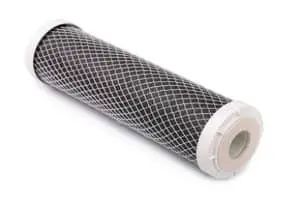
The Activated Carbon Block is composed of fine carbon powder that held together and remains static by a binding agent.
It’s very effective in removing Chlorine taste and odor, chemicals, and more contaminants in water.
Also, the Activated Carbon Block is able to reduce contaminants like lead, volatile organic compounds (VOCs), and microscopic cysts in water.
The high porosity powder form resulting in a larger surface area, which allows it to adsorb more contaminants in water and prevent water from channeling.
It also has high resistance against bacterial growth due to the tiny pore size.
How Activated Carbon Block Filter Works
When the water flows through the pores of an activated carbon block, all the impurities with size larger than the size of the pores are mechanically adsorb and accumulate on the activated carbon surface.
At the same time, the positively charged activated carbon attracts all the negatively charged chemicals like Chlorine and get rid of the bad taste and odor.
The Advantages of Activated Carbon Block Filtration:
- Affordable price and high value (performance-to-cost ratio)
- Great contaminants filtration capability
- Very effective in removing Chlorine taste and odor
- Customizable for different designs and applications
- Good water flow rate
- Long filter life
- Retain essential minerals
- Minimal pH level change
- Inhibit bacterial growth
- Easily to be used in conjunction with other filtration technologies for greater filtration
- Doesn’t require a power supply
- Green technology
- No chemical additives
The Disadvantages of Activated Carbon Block Filtration:
- Can’t achieve a very high water flow rate
- Require a separate sediment filter (for large sediments) to prolong its lifespan and work efficiently
- Cannot remove viruses
- Cannot remove excess minerals and dissolved solids
3. Granular Activated Carbon (GAC) Filtration
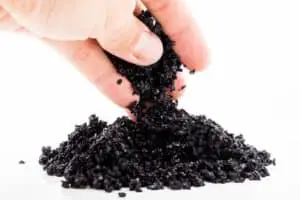
Perform a similar function as the activated carbon block like getting rid of chlorine taste and odor.
The Granular Activated Carbon contains loose carbon granules that are larger than carbon block powder, result in weaker contaminants adsorption but higher water filtration rate compared to carbon block.
It can be used as a pre-filter to protect the carbon block filter from larger particles and achieve greater removal for Chlorine taste and odor, chemicals, and other contaminants in your tap water.
The high water flow rate makes it suitable to be used for high-flow and low-intensity filtration, such as point of entry (POE) whole house filtration system, commercial and industrial filtration applications, point of use (POU) inline water filter, and as a part of a multi-stage filtration system.
How Granular Activated Carbon Works
Similar to activated carbon block, the carbon granules absorb the contaminants in water that are larger than the size of its pores when flowing through it.
The activated carbon granules will also attract the Chlorine that carried negative charge to it. Also, the carbon material itself will absorb the bad taste and smell from the water.
The GAC granules are often used with KDF media to improve efficiency and lifespan.
The Advantages of Granular Activated Carbon Filtration:
- Inexpensive
- High water filtration and flow rate
- Good contaminants filtration capability
- Effective in getting rid of Chlorine taste and odor
- Long filter life
- Retain essential minerals
- Minimal pH level change
- Easily to be used in conjunction with other filtration technologies for greater filtration
- Doesn’t require a power supply
- Green technology
- No chemical additives
The Disadvantages of Granular Activated Carbon Filtration:
- Weaker filtration especially against smaller size contaminants
- May happen water channeling issue due to loose carbon granules
- The lower density of its carbon granules may cause bacterial growth
- Cannot remove viruses
- Cannot remove excess minerals and dissolved solids
4. Reverse Osmosis (RO) Filtration
Reverse Osmosis is a filtration technology that utilizes a semipermeable membrane (or called RO membrane) to separate inorganic contaminants from water and produce the cleanest drinking water.
It’s capable to remove the majority of contaminants (up to 99%, including minerals) from water except for most soluble volatile organic compounds (VOCs), some pesticides, solvents, and chlorine.
Of course, behind the high intensive filtration does come with some costs like a higher price, slow filtration rate, and produce a large amount of brine (usually 3:1 wastewater to filtered water ratio).
And because of its slow water filtration rate, most of the reverse osmosis filtration system comes with a pressurized tank to store the filtered water.
The RO membrane is vulnerable to chlorine, so you’ll always see at least one activated carbon filter in a Reverse Osmosis filtration system as a pre-filter to remove chlorine.
How Reverse Osmosis (RO) Works
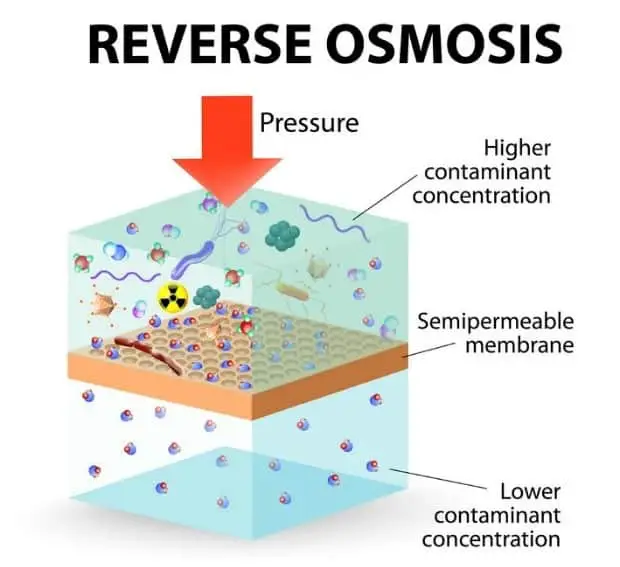
It’s the reverse version of the osmosis process.
In the reverse osmosis process, the molecules in the water are forced to pass through a semipermeable membrane from a more concentrated solute into a less concentrated one.
The pore size of the Reverse Osmosis membrane can down to 0.0001 microns, which make it capable to remove up to 99% of contaminants in water including microorganisms like bacteria and cysts.
The accumulated contaminants on the membrane surface will then be flush away to drain as brine (wastewater) to keep the RO membrane clean and make it last longer.
The filtered drinkable water will then be stored in a pressurized water tank for later use.
The Advantages of Reverse Osmosis Filtration:
- Offer the strongest filtration against the majority of contaminants found in water
- Able to remove or significantly reduce dissolved solids, iron, calcium, lead, cysts, mercury, bacteria, and more contaminants
- Produced the purest and cleanest drinking water
- Extra long lifespan RO membrane (2-3 years) due to being washed constantly
- Low total dissolved solids (TDS) value of filtered water
The Disadvantages of Reverse Osmosis Filtration:
- Does not remove chlorine, some pesticides and organic chemicals, solvents, and volatile organic compounds (VOCs)
- Produce a large amount of brine (wastewater) during the filtration process
- Slow water filtration rate
- Remove essential minerals in water and lower down water pH level
- Require a water tank for filtered water storage
- Cannot be used alone to treat chlorinated tap water
- Higher cost
5. Distillation
Distillation is a water purification process that has been using since long time ago.
It may not as popular and widely used as the activated carbon filter and reverse osmosis filter, but it does its job well in purifying the water.
How Water Distillation Works
The water distiller first evaporated the water by heating it to the boiling point using electrical energy. Then, the steam is captured and condensed into pure distilled water in liquid form.
In the process of vaporizing and condensing, the contaminants in water including essential minerals are left behind and get discarded later.
Except for the volatile organic compounds (VOCs), because they will be vaporized and condensed into distilled water as well due to their boiling points lower than 100℃.
The whole water distillation process takes quite some time to produce only a small output of distilled water, which make the application limited (mostly used for industrial processes only).
The Advantages of Water Distillation:
- Strong water purification
- Remove the majority of contaminants found in water
- Able to remove dissolved solids, excess minerals, and bacterial
- No filter cartridge replacement needed
The Disadvantages of Water Distillation:
- Time-consuming process
- Low output
- Require careful maintenance
- Consume electricity power
- Higher operating cost
- Remove essential minerals in the water
- Flat distilled water taste
- Higher cost
- Cannot remove organics with a boiling point lower than 100℃ (or 212℉)
6. Ion Exchange (IX)
Ion exchange is a process of removing undesirable dissolved ions from water and replacing them with other ions with the same electrical charge from the ion-exchange resin.
The chemical reaction happens when the water passes through the IX vessel with specialized resin, either in batch or continuous mode.
There are two types of ion-exchange processes, which are the cation exchange process (for positively charged ions) and the anion exchange process (for negatively charged ions).
In water treatment, the two ion-exchange processes are usually used for water softening and deionization purposes like demineralization, acid absorption, and metal removal.
How Ion Exchange Works
In the water softening process, the IX resin with positively charged sodium ions will capture the scale-forming positively charged calcium and magnesium ions in water and release the sodium ions to the water for exchange.
While for the deionization process, it can either exchange positively charged ions (cations) or negatively charged ions (anions).
In the anion exchange process, the negatively charged ions in water like fluoride, arsenic, nitrate, uranium, sulfate, and more get removed and exchanged with other desirable negatively charged ions like chloride (CI‾).
And when the ion-exchange resin capacity is fully used up, it will be undergoing a process called regeneration to restore the initial condition in the IX resin using regenerant like sodium chloride solution and hydrochloric acid.
The water softening and deionization is often used in water filtration system at home together with other filtration technologies like Reverse Osmosis (RO) and Activated Carbon.
The ion exchange process is effective in removing dissolved inorganic contaminants but weak against organic contaminants and microorganisms.
Recommended Read: Best Water Softeners for Whole House
The Advantages of Ion-Exchange Method:
- Inexpensive
- Effective against dissolved inorganics contaminants
- Able to remove arsenic, fluoride, nitrates, sulfates, uranium, and more negatively charged contaminants
- Able to remove manganese, iron, chromium, magnesium, calcium, and more positively charged contaminants
- Regenerable for continuous usage
The Disadvantages of Ion Exchange Method:
- Cannot remove sediments, organic contaminants, and microorganisms
- The Ion-Exchange (IX) resin is vulnerable to bacterial growth
- High operating cost
7. Ultraviolet (UV) Disinfection
In water treatment, ultraviolet technology is often used to kill microorganisms like viruses, Cryptosporidium, protozoa, Cysts, E.coli, Coliforms, Infectious, Typhoid fever, Giardia, Hepatitis, and bacteria in water from private wells, lakes, streams, and rainwater.
It can also be used to fight against chlorine-resistant microorganisms like Cryptosporidium for municipally treated water.
The UV ray from the ultraviolet lamp will damage and destroy 99.99% of microbiological contaminants in water that may cause illness, giving you peace of mind in consuming your daily drinking water.
However, a UV lamp is always additional protection and not a water filter, so you still need a water filtration system to filter out contaminants and chemicals in the water.
How Ultraviolet (UV) Disinfection Works
When water containing microorganisms pass through the UV lamp section, the UV ray energy emitted from the lamp will damage the microorganisms’ cells and kill or deactivate them.
The microorganisms with thicker cells will require a higher power UV lamp to sterilize them.
Since the UV ray only travels in a straight line, it’s necessary to first filter out sediments and other contaminants in water that may block or scatter the UV ray resulting survival of microorganisms.
It’s best to place a UV disinfection system in the last part of a home water purification system for the best efficiency.
The Advantages of Ultraviolet (UV) Disinfection:
- Able to kill 99.99% of harmful microorganisms in water
- The quick and reliable disinfection process
- Simple maintenance
- Chemical-free solution for microorganisms
- Low energy consumption
- Low operating cost
- Safe and environmental-friendly
The Disadvantages of Ultraviolet (UV) Disinfection:
- Rely on electricity supply to work
- Only remove microorganisms in water
- The residual particles in the water will reduce the efficiency in destroying microorganisms
- Require a prefilter to block out particles and impurities in water
- Require frequent monitor for UV lamp and light tube
- Cannot be used standalone to purify the water
- Higher upfront cost
8. UltraFiltration (UF)
Ultrafiltration technology makes use of hydrostatic pressure to force the water flowing through a submicron semipermeable UF membrane (usually made from 0.01 to 0.5 microns hollow fiber) to filter out most of the contaminants in water.
The small microns rating UF membrane (0.01 to 0.02 microns) is also capable to remove microscopic contaminants like parasites, bacteria, and viruses while retaining the essential minerals.
As the UF membrane cannot filter out dissolved solids in water, it’s only suitable to treat water with a low concentration of total dissolved solids (TDS).
The hollow fiber UF membrane has high resistance against chemicals like Chlorine, allow it to filter municipality treated water without rely on the activated carbon as a prefilter.
But for drinking water treatment, ultrafiltration is usually combined with other filtration technologies like sediment, activated carbon, and reverse osmosis filtration to cover its drawbacks and to cover others’ drawbacks in order to work more effectively.
Ultrafiltration technology is also often used in industrial application and wastewater recycling process.
How Ultrafiltration (UF) Works
The ultrafiltration mechanism is similar to Reverse Osmosis filtration.
When the water flowing through the hollow fiber semipermeable UF membrane with 0.01 microns pores size, all the contaminants in water with size larger than 0.01 microns are blocked and accumulated on the outer membrane surface, leaving clean drinkable water.
The Advantages of Ultrafiltration (UF):
- Reliably strong filtration capability down to 0.01 microns
- Effectively remove the majority of contaminants in water including parasites, viruses, bacteria, turbidity, and most pathogenic organisms
- Retain essential minerals in the water
- High resistance against chemicals in the water
- Fast water flow rate
- Environmental friendly
- Simple installation and replacement process
- Can operate under low water pressure
- Long lifespan (about 2 years)
The Disadvantages of Ultrafiltration (UF):
- Cannot remove Chlorine taste and odor.
- Cannot remove dissolved solids like salts, fluoride, and more
- Not effective against organics contaminants like cysts and volatile organic compounds (VOCs)
9. Activated Alumina (AA) Filter
Activated Alumina is a water filter made by highly adsorptive porous aluminum oxide (bauxite) that specifically designed to remove fluoride, arsenic, selenium, and thallium in water.
It’s often used in the water filtration system at home to treat fluoridated tap water.
Before the Activated Alumina filter can be used to remove contaminants, it has to go through an initialization process first, which include the backwashing and chemical treatment on the activated alumina media.
How Activated Alumina Filter Works
When the tap water flows through the filter media that consist of activated alumina granules, the fluorides are adsorbed on the surface of activated alumina.
The amount of fluoride adsorb depends on the contact time between tap water and the activated alumina.
Advantages of Activated Alumina Filter:
- Effectively remove 99% of Fluoride in water
- Can remove Arsenic, Selenium, and Thallium in water
- Can be regenerate
Disadvantages of Activated Alumina Filter:
- Limited contaminants removal
- Require periodic cleaning with a regenerating agent
- Have to use in conjunction with other water filters to provide safe drinking water
- May leach aluminum to water if not properly tested or operate under optimized condition
10. Ionization
Water ionizer (also known as the alkaline ionizer) uses a water treatment method called water ionization (or water electrolysis) to change the water molecular structure in order to produce both antioxidant-rich ionized alkaline water (for consumption) and oxidizing ionized acidic water (for external uses like cleansing and disinfecting).
The water ionizers also give you the option to adjust the output water pH to the desired level (between 3 to 12).
How Water Ionization Works
First, the incoming tap water will pass through an internal filter to reduce some contaminants and chemicals, but leaving some impurities in water for the water ionizer to function properly.
Next, the water will flow to a low-voltage plate that contains a positive and negative electrode to undergo a process called water electrolysis.
Then, the two electrodes with a different pole (positive and negative) will attract the heavy metals, minerals, and other impurities in water according to their electrical charges.
Cations and positively charged ions will go to negative pole electrode to create alkaline water. Anions and negatively charged ions will go to the positive pole electrode to create acidic water.
The ionization process also separating the oxygen and hydrogen in water, resulting in both antioxidant-rich alkaline (OH-) and acidic (H+) streams.
The Advantages of Water Ionization:
- Produce great taste antioxidant-rich alkaline ionized water (ORP between -50 to -350)
- Produce acidic water for external usages
- Able to adjust water pH level to suit your needs
The Disadvantages of Water Ionization:
- Require an electricity supply to work
- Weak water filtration capability
- Cannot remove total dissolved solids (TDS), pharmaceuticals, and organic contaminants in water
- The functionality of a water ionizer may not as claimed by the manufacturer
- The benefits of alkaline ionized water are arguable and lack of scientific proof
- Expensive
Common Home Water Purification System Setup
There are few different setups of basic and advanced water filtration system at home, either for point of entry (POE) purpose like a whole house water filter or point of use (POU) purposes like for bathroom, washing machine, drinking, kitchen use, and more.
Here’s the 7 common home water purification system setups:
- Basic
- Water Pitcher
- Faucet Water Filter
- Single-stage Countertop Water Filter
- Single-stage Under Sink Water Filter
- Advanced
- Multi-stages Countertop Water Filtration System
- Multi-stages Under Sink Water Filtration System
- Gravity Drip Water Filter
Water Pitcher
As a water pitcher only have one filter, so it’s usually an activated carbon filter or a mixed media filter that consists of a layer of sediment filter and activated carbon block or granules.
It aims to provide the basic water filtration need with the simplest setup (no installation needed, just buy and use).
Due to its lightweight design, you can just carry it around in the house and outdoor.
Want to drink cold water? Just put it in the fridge and enjoy a moment later.
Recommended Read: Best Water Filter Pitchers for Your Home
Faucet Water Filter
Faucet type of water filter is designed for families who are looking for basic water filtration with continuous filtered water supply.
Its compact-size body that attached to your faucet makes your kitchen look neat and will not take up any countertop space.
Once the faucet filter is installed and ready, just turn on your faucet to enjoy your clean drinking water.
Single-stage Countertop Water Filter
A single-stage countertop water filter is suitable for people who need basic water filter but don’t wish to change their filter that often.
The countertop water filter usually come in higher capacity, allowing longer usage before the filter needs to be replaced.
Single-stage Under Sink Water Filter
Usually, for a single-stage filter, the under sink set-up is more preferred by most people as the countertop space is more precious.
By installing and hiding the water filter, piping, and valve at the under sink area, it makes the kitchen look better aesthetically.
Multi-stages Countertop Water Purification System
If you need a more advanced water filtration for your home, you’ll have to go for the multi-stages water purification system which consists of 2 or more water filters linked together.
There’s no single filter that can effectively remove all type of contaminants in water, so you have to use multiple filters with each of them deal with specific contaminants to achieve greater filtration capability.
But more filters also mean bulkier, so if your countertop doesn’t have much space, just go for the under sink set-up.
Multi-stages Under Sink Water Purification System
The 3-stages (and above) under-sink water purification system is the most widely used advanced water filtration system for home.
More families are preferred to use it because of the strong filtration capability and only occupy under-sink space.
For instances, the popular Reverse Osmosis (RO) filtration system, advanced direct flow-through filtration system, Ultrafiltration (UF) system, RO with alkaline post filter, filtration system with ultraviolet (UV) disinfection, and more are all multi-stages water filtration system.
Gravity Drip Water Filter
Gravity drip water filter is a multi-layer water filtration system that is mainly used for outdoor and traveling purposes.
It’s also suitable for people with no kitchen access and renting a room due to its portability, all you need to do is pour the unfiltered water into the container area, wait for a moment, and get your clean drinking water from the collection area.
Summary for 10 Types of Water Filtration System at Home (Comparison Table)
Here’s the comparison table of the 10 types of water purification technologies:
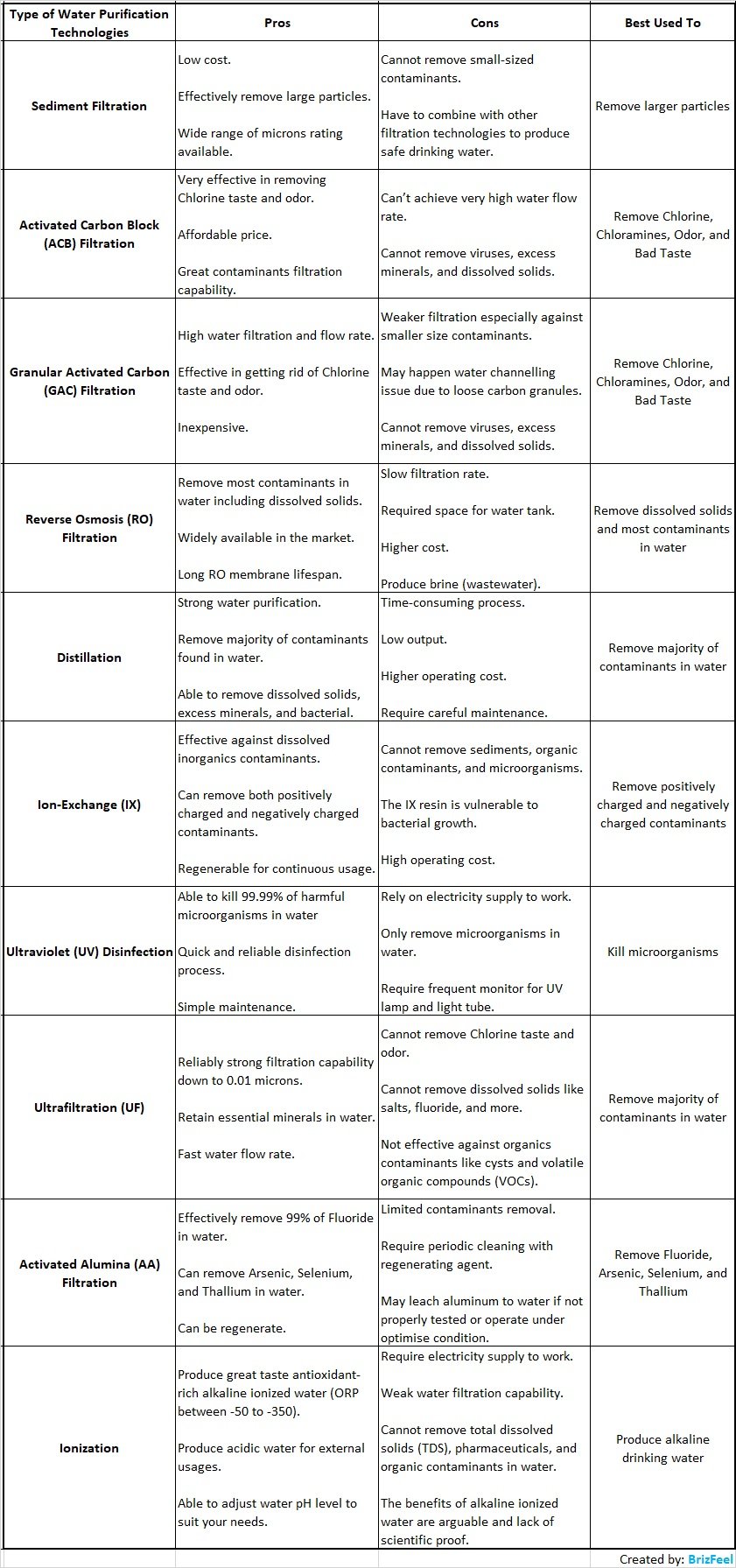
Still unsure how to pick the right filters?
No worries, just read on and I’ll guide you on choosing the best water filtration system at home.
How to Choose the Best Water Filtration System at Home
If you are wondering, “which types of home water purification system is best for me?”
Here are the 3 simple steps to choose the right water filter for your home and family:
- Know your water contaminants
- Know the water filters that are capable to remove them
- Choose according to your situation and preferences
1. Know Your Water Contaminants
The most accurate way to know the contaminants in your water source is to get the test report from the lab.
Otherwise, you may get the information from your water treatment company or consult the water treatment expert.
Once you identified the contaminants in your water, then move on to review the different water filters in the market.
2. Know The Water Filters That Are Capable To Remove Them
There are 10 common types home water purification system in the market, each with different contaminants removal capabilities, pros & cons, and cost.
Once you know what contaminants you need to get rid of, just refer to my contaminants removal table below and pick the filters accordingly.
Here’s the table I made for you guys to save your time:
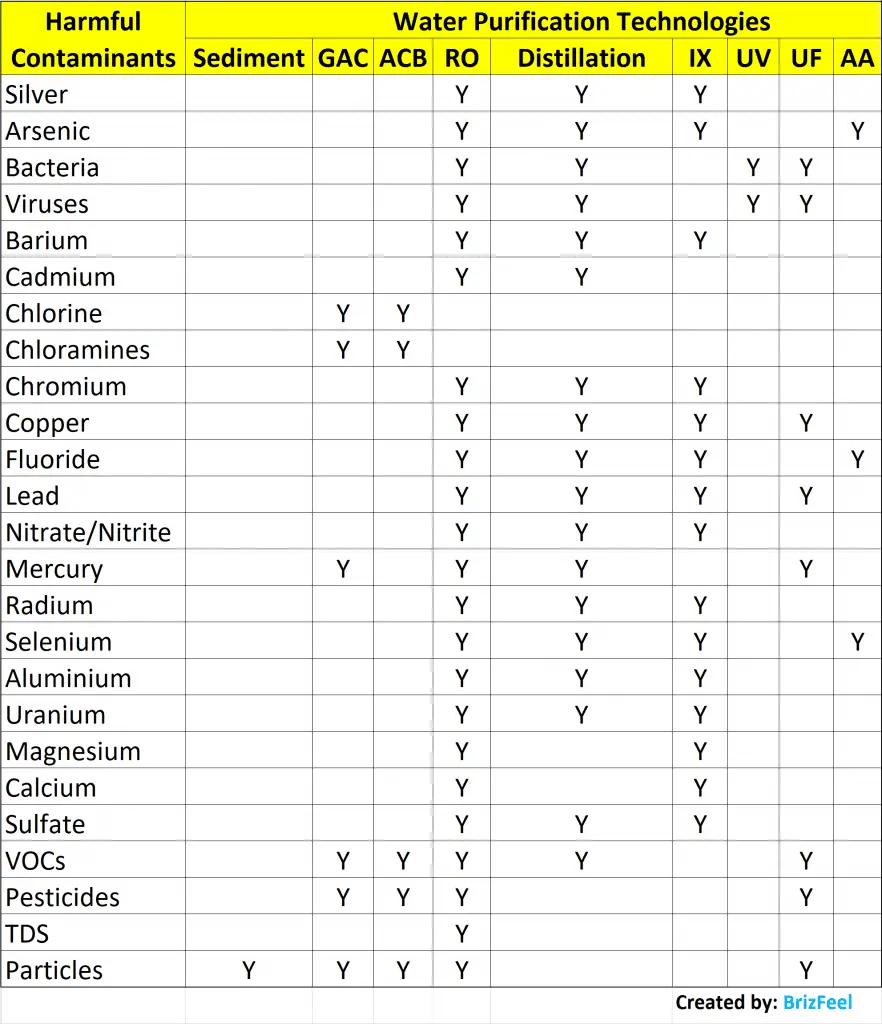
Depending on your water quality and the number of contaminants you want to remove, you may build a water filtration system at home that consists of 2 to 6 stages.
I always recommend getting a sediment filter in conjunction with any other type of main filtration system you want to use.
Sediment filter acts as a first layer to block off all the large particles and protect the main filtration system from getting clogged and work more efficiently.
Moreover, it’s cheap and can be replaced frequently.
As per the contaminants removal table above, you can see that the Reverse Osmosis (RO) filtration provide the best filtration coverage against the widest range of contaminants.
Therefore, if you are looking for high intensive water filtration, you can’t run away from Reverse Osmosis filter. Of course, you’ll also need an Activated Carbon Block (ACB) to get rid of chlorine before the RO filter.Recommended high intensive filtration combinations:
- Sediment + Activated Carbon Block (ACB) + Reverse Osmosis (RO)
- Sediment + ACB + RO + Granular Activated Carbon (GAC)
- Sediment + GAC + ACB + RO
- Sediment + GAC + ACB + RO + Ultraviolet (UV)
If you are using municipally treated water that is soft and good quality, then you may not need to go for a reverse osmosis filtration system, just get a good quality sediment filter and activated carbon filter will do.
If you need more filtration power, then get the ultrafiltration (UF) filter and place it before the activated carbon filter.Recommended low to medium intensive filtration combinations:
- Activated Carbon Block (ACB) – Entry-level filtration
- Sediment + ACB
- Sediment + ACB/GAC + Ultrafiltration (UF)
If you are using private well water, I’ll highly recommend you to get an ultraviolet (UV) filter to kill microorganisms. And since physical particles will reduce the efficiency of a UV filter, it’s necessary to get a good sediment filter in front of a UV filter.
Also, you’ll need a Sulfate removal filter to get rid of sulfate odor.Recommended filtration combinations for private well water:
- Sediment + RO + UV
- Sediment + UF + RO + UV
If your water quality is considered good but needs to get rid of fluoride, arsenic, selenium, and thallium, then the activated alumina (AA) is what you need to put in your water filtration system.Recommended filtration combinations for fluoride, arsenic, and selenium:
- Sediment + Activated Alumina (AA) + ACB
- Sediment + GAC + Activated Alumina (AA) + ACB
3. Choose According To Your Situation And Preferences
If you are in this step, that’s mean you already know the common contaminants in your water and which water filters you need in order to remove them.
But practically, you need to find a home water purification system that suits your current situation.
For instance, if you only have a limited budget, you may need to sacrifice some filtration power for lower cost, or if you have limited kitchen space, then you have to choose a smaller size water filter instead.
What Is Water Filter Performance Certification
The water filter performance can be tested and certified according to the standards developed by NSF International (NSF) and the American National Standards Institute (ANSI).
The standards also adopted by other certification providers like the Water Quality Association (WQA) for water filter product certification.
It’s based on the contaminants reduction in water to below the Maximum Contaminant Level (MCL) determined by the US Environmental Protection Agency (EPA) and different types of filtration technologies are tested by different standards.
For instance, the NSF/ANSI standard 42 and 53 is for carbon filter, standard 58 is for a reverse osmosis filtration system, and standard 62 is for distillation.
The water filter product performance certification is mandatory in some states, while most other states are voluntary.
The NSF/ANSI certification is helpful for consumers in selecting their home water purification system, and also beneficial to the manufacturer in marketing their water filtration products.
What Can You Do to Prevent Water Pollution Getting Worse
I believed now you already know that there are many different contaminants in our water which caused water pollution, and the amount keeps increasing.
But, do you aware that there’s something we can do together to prevent or reduce the number of contaminants in our water source?
It’s not hard to do at all, just some simple caring actions to our environment:
- Reduce plastics usage
- Get a good water filtration system at home and get away from bottled water
- Avoid using pesticides and herbicides for your plants or trees
- Dispose of your used chemical liquids, expired medicines, oils, and non-biodegradable products properly
- Be a civilized person and do not litter
Simple right?
So let’s do it from now onward!
Frequently Asked Questions
Here’s the list of FAQ regarding water filtration.
1. What’s the ideal pH level of tap water?
The Ideal pH level of tap water is 7.5. The pH level between 7.0 and 8.0 is preferable because if the tap water pH level is below 7.0, the acidity may cause corrosion to pipes, appliances, and fixtures. If the pH level is above 8.0, the alkalinity may produce minerals deposits inside the pipes and on floors.
2. What are the common type of water filtration system in the market?
The common type of water filtration system in the market are sediment filter, activated carbon block filter, granular activated carbon filter, reverse osmosis filter, distillation, ion-exchange, ultraviolet disinfection, ultrafiltration, activated alumina filtration, and ionization.
3. How long you need to replace your water filter cartridge?
It depends on the water filter capacity and family usage.
For most standard capacity activated carbon filter, it should be replaced at least once every year.
Reverse Osmosis membrane filter can last up to 3 years due to its self-wash mechanism.
Sediment filter like Polypropylene (PP) should be replaced more frequently, typically from 3 to 12 months time depending on usage.
Most of the time, the filter will come with a certain capacity in gallons, so you can find out your average monthly water usage and calculate the replacement period accordingly.
4. How to know whether the filter cartridge is clogged?
You can measure the pressure drop by installing pressure gauges before and after the filter.
When the filter cartridge is new, run the water filtration system and write down the difference of pressure reading (let’s say 2 psi). Then measure again after a few months, you’ll notice the pressure difference is increasing, let’s say to 7 psi.
When the difference of 2 pressure gauges reading reach about 15, it’s time to change the filter cartridge (or wash if it’s washable).
5. How to choose the right filter that can remove the contaminants in my water source?
The best way is to have your water tested on lab to identify the contaminants, and then pick the right water filters to remove those contaminants.
6. Can a TDS meter really measure the Total Dissolved Solids in the water?
The answer is no.
I have seen many people used a TDS meter or TDS pen to measure Total Dissolved Solids in their water without knowing what is really being measured.
In short, what TDS meter measured is the electrical conductivity (EC) in water (pure H2O has virtually zero EC), and then times the EC value by a factor between 0.5 to 1 (set by the manufacturer) to estimates the TDS (which is not the real Total Dissolved Solids in water).
For instances, dissolved organic solids (eg: sugar) and microscopic solid particles (eg: colloids) are not measurable by the TDS meter because they do not affect the water conductivity significantly.
The accurate way to measure the actual TDS in water is to evaporate the water and then weighing the dissolved residue left.
7. Is the water filter brand important?
Not absolutely but is recommended if it’s a highly reputable brand in term of product safety, quality control and customer support.
As we discussed earlier, the important parts of considering a water filter are about the material of the components, where the components are manufactured, and the functionality of the filter system.
So more importantly, choose a water filter which all its components are manufactured by reputable companies with strict material control and strict quality control (eg: US-based manufacturers).
8. If the water filter is “Made in USA”, is that mean it’s 100% safe and good?
Not really. For example, a water filter company bought all the low-quality components from elsewhere and assembled in the USA, the company is allowed to say the water filter is “Made in USA”, but this doesn’t justify the product quality and safeties.
What you really need to know is where the components (which used to build the water filtration system) are manufactured. For instance, if all the components are made in the USA and assembled in Thailand, then the water filtration system is considered safe.
9. Is NSF certification required?
The answer is no, but it’s recommended to have NSF certified for all components that have contact with water (especially for smaller brands).
NSF is a certification system and not a quality control system, so it can’t guarantee the filter performance in the long run and the quality of your filter when it’s manufactured (since thousands of filters are being manufactured and shipped to customers directly without going through NSF).
Conclusion:
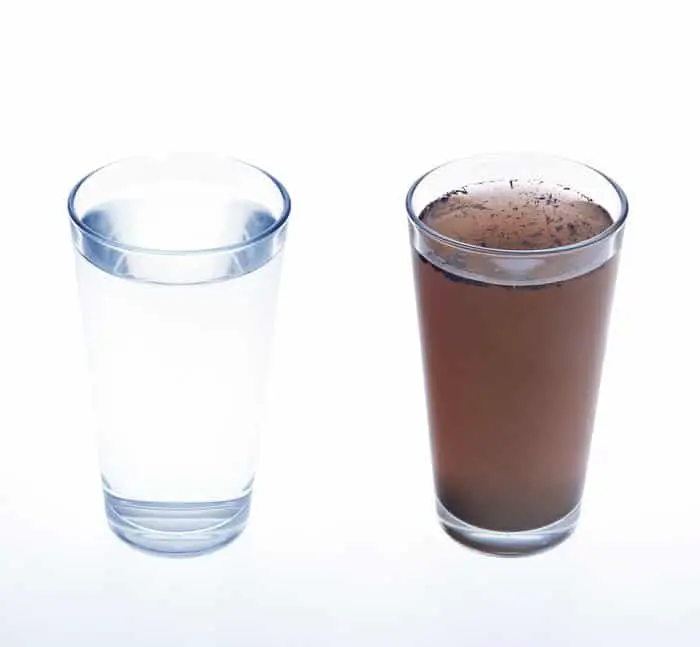
There will always some contaminants in your water source, whether it is from municipal or private wells, it’s the fact and you can’t control it.
But you can do your part to remove the contaminants in the water entering your house by using a water filtration system, and that’s the important step to protect you and your family from harmful contaminants on a daily basis.
At a minimum, get a good point of use (POU) water filter for drinking water. And if budget is allowed, get a point of entry (POE) whole house water filtration system in order to enjoy clean water for showering, clothes washing, and cooking.